-
Posts
465 -
Joined
-
Last visited
Content Type
Profiles
Personas
Wiki
Rules
War
Systems
Safety
Player Conduct
Forums
Forms
Posts posted by Sander
-
-
Hello everyone! Sander here,
A few days ago I figured out how to add sounds to a figura model. (For those of you who don't use the figura mod, ignore this guide or get figura. Seriously it's really good, it's like moreplayermodels but better, look it up!) So far I haven't heard of anyone else in the LOTC community who uses figura having figured this out before, and when I asked people in the discord if they wanted a guide some folks seemed very eager so here we are!
Let me just say; figuring this out was a pain, since I didn't know squat about blockbench's animating, lua scripting or how the intricacies of figura worked. Now that I know how to do this though, I can tell you it's super easy and you too can add cool sounds to your models using this simple guide!Step 1: Open your model in blockbench and go to the "Animate" tab (credit to gaiusmarius/IbnKhaldun8 for this lovely model).
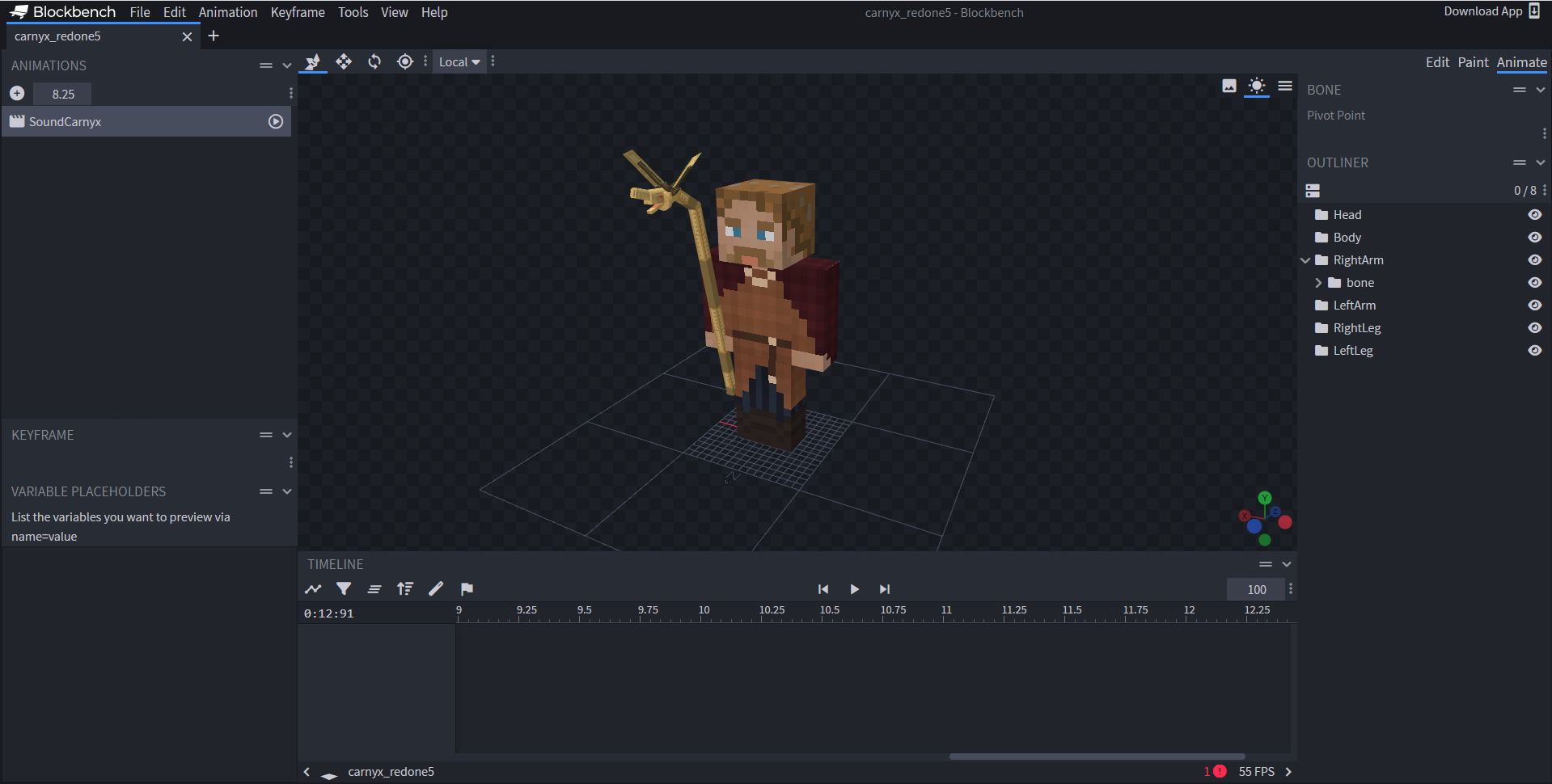
Step 2: In this tab, click on the plus button on the left of the screen to create a new animation, and name it (do NOT put . or other punctuation marks in the name, keep it simple).
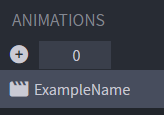
Step 3: Now that you've made the new animation, go to the bottom of the screen where it says 'Timeline' and click on 'Animate Effects'. This adds the Effects tab with the options 'Particle', 'Sound' and 'Instructions'. You can ignore the 'Particle' option.

Step 4: Select a point of time on the Timeline (Example is 0.25, I recommend not doing 0.00 because it might be bugged). This is where your animation (sound) will start. Then click on the + icon for Sound, which adds a so-called 'Sound Keyframe'. Options for these keyframes are displayed on the left. Click on the button that says 'Select Keyframe File' and upload the sound file that you wish to use. Note that you need to use a .ogg file, it seems .mp3 or other formats do not work with either blockbench or figura. (If you have a .mp3 file, you can easily convert it using various websites for free).
IMPORTANT: Every second of a .ogg file is roughly 10kb. Your figura avatar can at most be 100kb. The sound is not the only thing taking up this space, so just to be safe try to keep your sound to 8 seconds at max.
Step 5: Now that you have added the sound file, create an 'Instructions Keyframe' in the same manner you've created the Sound Keyframe (do this at the same point in the timeline). You'll find that in this keyframe, instead of an Effect box where you can upload a file, there is a Script box you can type in. Paste this following script into that box, with 'ExampleSound' being whatever you named the sound file at Step 4:
sounds:playSound("ExampleSound",player:getPos())
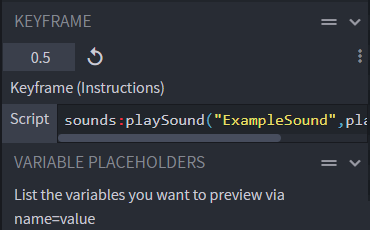
Step 6: You have created both Keyframes now. If you press play to run the animation, you should be able to hear the soundfile you uploaded. Good job, I'm so proud of you! Now, download your .bbmodel file (blockbench model) and put it in your avatar folder as per usual. Not as per usual though, also put the .ogg file you used into the avatar folder. If you don't put the .ogg file in the folder, figura will have no clue what sound file your bbmodel is referencing.
IMPORTANT: Make sure that the .ogg file is also called 'ExampleSound' or whatever name you gave it, between the file in the folder, the Effect in the Sound Keyframe and the Script in the Instructions Keyframe, there can be NO difference in name.
Step 7: Getting close now! Also put a script file in your avatar folder in case you don't have a script file in there yet. At the bare minimum, your script file should look like this, with the following line of code. YourBBModelName is whatever you called the .bbmodel you put in the avatar folder and ExampleName is whatever you named your animation at Step 2. Make sure to SAVE the script file before closing it.

Step 8: The line of script you added in Step 7 will cause the sound animation to be played whenever you select (played client side) and upload (others can hear it too) the avatar ingame. If you want to play the sound again, just select and upload the avatar again, people won't notice a difference. If you want to trigger the sound animation in some other way, you could try scripting it to run repeatedly, through using the action wheel or if certain criteria are met. This is simply the most basic way to have the sound animation be triggered.
That's basically it though! If you did everything right, you should now be able to simply close the folder you put everything into and try equipping the avatar ingame, upon doing which the sound should play for you.If you have any questions because following these steps didn't work or you have follow up questions; feel free to send 'em my way and who knows I might be able to help.
(I won't promise I can though, I'm still pretty new to all of this myself!)
Hope this was useful to my fellow figura users!
15 -
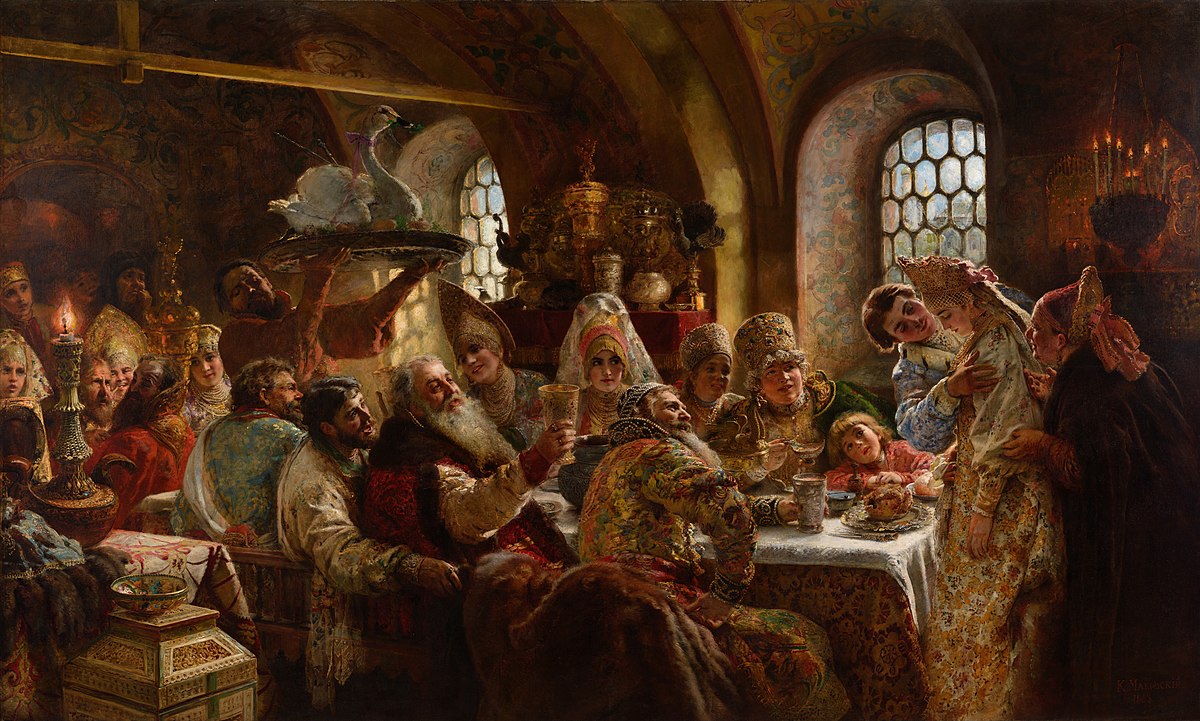
The Failor Feast
With people having settled into the landmass of Failor, the time has come for canondom to reflect on recent events and come together to talk about the troubles we still face. Thus the Lords of the Marches of Lecho-Raev and Reinmaren as well as Father Arnaud of Horensberg invite the various Canonist lords who have not yet been slain by the Azdrazi, Mori, Pagans or Undead, to come together for feasting and merriment at the Horensburg Church Estate. All canonists are welcome, but seats are limited. Attendees not knowing how to get to Horensberg can come to Lecho-Raev and will be taken from there.
Special invitations go out to;
King Georg of HaenseKing Adrian of Balian
King Tar-Uriel of the Adunians
King James of AaunCount Jan of Vaska
Lord Markus Sarkozic...or their representatives.
Signed,
Father Arnaud
Count Waclaw
Baron Manfred
((Monday, 29-5, 5pm EST))
((Not a super serious event, just a fun lil get together to have a bit of rp while we're here))
14 -
APPARATUM ECCLESIARUM;
OR,
THE EQUIPMENT OF THE CHURCHESFor the Outfitting, Supplying and Adorning of our Tabernacles;
The Chapels, Churches, and CathedralsBy Father Arnaud
FOREWORD
To my dear brothers and sisters of the Faith, blessings be upon you.
This writ, which I have sought to name Apparatum Ecclesiarum, serves as instructions and a guide for all of you, written by one of your own. In the first place, it serves as a guide to my brothers of the cloth; the clergymen of our Holy Church. Additionally however, I ask that any among the Canonist laity take note of this guide and ensure that their place of worship meets the requirements I have put forth here. For that is what this guide will service; a list of the furnishings, appliances and amenities that a properly outfitted Canonist tabernacle requires for its function. These will be divided into that which is mandatory to have (for the purposes of providing in the Sacraments or otherwise) and that which is optional to have (because it is preferred but has alternatives, or because it is not mandatory but still adds to the functionality of the tabernacle). I hope this guide serves you all well, that our Church may find use in it for providing for our flock, and that the Lord be pleased with our proper adornment of His Holy places.CHAPELS
CONSECRATION - MANDATORY
All sacred places meant for worship require being made holy according to the Rite of Consecration, for which four wooden stakes, a mallet and a vessel of holy water are required.ICONOGRAPHY & RELICS - OPTIONAL
Iconography, or imagery of Saints and other Holy Figures as well as one or multiple relics, add to the Chapel as a point for the visitor to focus their worship towards.HOLY WATER - OPTIONAL
Holy Water, also known as the Water of Gamesh, is water that has been sanctified through the Rite of Consecration and can be present in the chapel in the form of a vessel for the purpose of cleansing.
ALTAR - OPTIONAL
An Altar is not required in a chapel, but can help focus the visitor’s worship as with Iconography. An Altar can additionally also be used for leaving offerings, lighting candles or performing sacraments. Preferably, the Altar should be on the eastern end of the Church, opposite the entrance, as the sun - a representation of GOD’s Holy Light, rises in the east. In Owynist Chapels, the Altar must have a fire or flame. In Ruskan Chapels, the Altar must be separated from the nave by an Iconostasis if there is space for such in the building.
VOTIVE CANDLES - OPTIONAL
Votive candles can be provided in the chapel to be used during prayer by the chapel visitor, or to be lit by visitors in remembrance of lost ones.CHURCHES
CONSECRATION - MANDATORY
All sacred places meant for worship require being made holy according to the Rite of Consecration, for which four wooden stakes, a mallet and a vessel of holy water are required.PASTOR - MANDATORY
A pastor, also known as a Parish Priest, is required for each Church. The pastor provides the parish that the Church encompasses with his services such as the sacraments and mass, as well as advising the parishioners and maintaining Church property in the parish.
HOLY SCROLLS - MANDATORY
A copy of the Holy Scrolls should be present in any Church, either publicly accessible to visitors and parishioners, or privately held by the Pastor.HOLY WATER - MANDATORY
Holy Water, also known as the Water of Gamesh, is water that has been sanctified through the Rite of Consecration and must be present in the Church both in a vessel and in a baptismal font. Holy Water is required in many sacraments, including the aforementioned baptism, for which the font is necessary.
BAPTISMAL FONT/BASIN - MANDATORY
A basin or font filled with the aforementioned Holy Water must be present in each church for the purpose of the sacrament of Baptism.
SACRAMENTAL CLOTH - MANDATORY
A cloth, preferably white or decorated, must be present in each Church for the use in sacraments. It may be used in the sacrament of Baptism for kneeling on in case the person or people being baptized do not fit in the basin or font, but it must be used in the sacrament of Matrimony for the covering of the joined hands of the bride and the groom.
ALTAR - MANDATORY
An Altar is required to be present in each Church for the purpose of Mass as well as leaving offerings, lightning candles and performing sacraments such as Matrimony at. Preferably, the Altar should be on the eastern end of the Church, opposite the entrance, as the sun - a representation of GOD’s Holy Light, rises in the east. In Owynist Churches, the Altar must have a fire or flame. In Ruskan Churches, the Altar must be separated from the nave by an Iconostasis if there is space for such in the building.
CONFESSIONAL - MANDATORY
A Confessional, also known as a Confession Booth, is mandatory to be present in every Church in order for the rituals of repentance and penance to be conducted, which are key in the absolving of sins.
AMBO/PULPIT - MANDATORY
An Ambo, Pulpit or both are mandatory to have in any Church, as they serve as the place from which the pastor speaks when conducting mass. An Ambo can be a smaller stand on the floor - preferably a raised part of the floor near the altar - that the pastor stands behind when he preaches, and can even consist of just a lectern. A pulpit is preferable for larger churches however, as its place as an elevated booth or platform above the heads of the parishioners means the priest’s voice is heard and his expressions are seen more easily.
SILVER HORN - OPTIONAL
A silver horn is recommended to be present in the Church for use in the Rite of Consecration for the blessing of water into Holy Water, as well as for use in the sacrament of Baptism. However since there are alternatives for these uses, the Silver Horn is not mandatory. As the Rite of Consecration states a ‘sacred symbol’ is a viable alternative to the Silver Horn, a chalice with religious significance is a recommended alternative.ICONOGRAPHY & RELICS - OPTIONAL
Iconography, or imagery of Saints and other Holy Figures as well as one or multiple relics, add to the Church as a point for the visitor or parishioner to focus their worship towards and as worthy decorations to adorn the Church. If the Church is large enough, stained glass windows, frescoes and murals are also recommended.
PEWS - OPTIONAL
In mainstream Canonist Churches, pews are mandatory as a place for the parishioners to be seated during services, though in both Owynist Rite and Ruskan Rite Churches, pews or indeed any place to sit during services are optional, with some traditionalist Churches of these Rites preferring to keep their parishioners standing.
PRAYER BOOKS - OPTIONAL
A set of prayer books or hymns may be made available to visitors or parishioners of the Church for reading during contemplation, prayer or singing hymns during Mass.VOTIVE CANDLES - OPTIONAL
Votive candles can be provided in the Church to be used during prayer by the Church visitor, or to be lit by visitors in remembrance of lost ones.DONATIONS BOX - OPTIONAL
A Church is recommended to have a donation box either in a fixed position near the entrance, or in portable form for walking down the nave. The donations collected in this could be used as alms for the poor or as a tithe for the Church to cover its expenses.CATHEDRALS
CONSECRATION - MANDATORY
All sacred places meant for worship require being made holy according to the Rite of Consecration, for which four wooden stakes, a mallet and a vessel of holy water are required.
BISHOP - MANDATORY
A Bishop, Archbishop or Patriarch is required for each Cathedral. These high-ranking Church officials not only rule and oversee all the parishes and Church affairs in their Diocese from their Cathedral, but also serve as the Cathedral’s parish’s Pastor. The Bishop thus provides his parish with services such as sacraments and mass just like a Pastor would.HOLY SCROLLS - MANDATORY
A copy of the Holy Scrolls should be present in any Cathedral, preferably publicly accessible to visitors and parishioners, or privately held by the Bishop.
CATHEDRA - MANDATORY
The namesake of the Cathedral, the Cathedra, is naturally mandatory in these buildings. It serves as the - sometimes merely ceremonial - throne from which the Bishop rules his Diocese. In case the Bishop is not the priest conducting an ongoing church service, it is also where the Bishop sits during said service. The Cathedra should preferably be placed behind the Altar.ALTAR - MANDATORY
An Altar is required to be present in each Cathedral for the purpose of Mass as well as leaving offerings, lightning candles and performing sacraments such as Matrimony at. Preferably, the Altar should be on the eastern end of the Cathedral, opposite the entrance, as the sun - a representation of GOD’s Holy Light, rises in the east. In Owynist Cathedrals, the Altar must have a fire or flame. In Ruskan Cathedrals, the Altar must be separated from the nave by an Iconostasis.HOLY WATER - MANDATORY
Holy Water, also known as the Water of Gamesh, is water that has been sanctified through the Rite of Consecration and must be present in the Cathedral both in a vessel and in a baptismal font. Holy Water is required in many sacraments, including the aforementioned baptism, for which the font is necessary.
BAPTISMAL FONT/BASIN - MANDATORY
A basin or font filled with the aforementioned Holy Water must be present in each Cathedral for the purpose of the sacrament of Baptism.SACRAMENTAL CLOTH - MANDATORY
A cloth, preferably white or decorated, must be present in each Cathedral for the use in sacraments. It may be used in the sacrament of Baptism for kneeling on in case the person or people being baptized do not fit in the basin or font, but it must be used in the sacrament of Matrimony for the covering of the joined hands of the bride and the groom.CONFESSIONAL - MANDATORY
A Confessional, also known as a Confession Booth, is mandatory to be present in every Cathedral in order for the rituals of repentance and penance to be conducted, which are key in the absolving of sins.AMBO/PULPIT - MANDATORY
An Ambo, Pulpit or preferably both are mandatory to have in any Cathedral, as they serve as the place from which the Bishop speaks when conducting mass. An Ambo can be a smaller stand on the floor - preferably a raised part of the floor near the altar - that the Bishop stands behind when he preaches, and can even consist of just a lectern. A pulpit is preferable for Cathedrals however, as its place as an elevated booth or platform above the heads of the parishioners means the priest’s voice is heard and his expressions are seen more easily.
ACOLYTE ROBES - MANDATORY
A Cathedral should have a few excess sets of attire for Acolytes in stock as to hand out to new recruits to the clergy that are being educated at the Cathedral.
ANOINTING OIL - MANDATORY
A vessel of anointing oil - usually olive oil that has been consecrated - should be present in any Cathedral for use in the Rite of Ordination where a single-barred cross is drawn with the oil on the forehead of an Acolyte to conclude their Ordination and make them a priest.SILVER HORN - OPTIONAL
A silver horn is recommended to be present in the Cathedral for use in the Rite of Consecration for the blessing of water into Holy Water, as well as for use in the sacrament of Baptism. However since there are alternatives for these uses, the Silver Horn is not mandatory. As the Rite of Consecration states a ‘sacred symbol’ is a viable alternative to the Silver Horn, a chalice with religious significance is a recommended alternative.ICONOGRAPHY & RELICS - OPTIONAL
Any Cathedral isn’t obligated, but is recommended to have plenty of iconography, or imagery of Saints and other Holy Figures as well as one or multiple relics. These form a point for the visitor or parishioner to focus their worship towards and also serve as worthy decorations to adorn the Cathedral. Stained glass windows, frescoes and murals as well as a reliquary to store the Holy relics are also recommended.PEWS - OPTIONAL
In mainstream Canonist Cathedrals, pews are mandatory as a place for the parishioners to be seated during services, though in both Owynist Rite and Ruskan Rite Cathedrals, pews or indeed any place to sit during services are optional, with some traditionalist Cathedrals of these Rites preferring to keep their parishioners standing.PRAYER BOOKS - OPTIONAL
A set of prayer books or hymns may be made available to visitors or parishioners of the Cathedral for reading during contemplation, prayer or singing hymns during Mass.VOTIVE CANDLES - OPTIONAL
Votive candles can be provided in the Cathedral to be used during prayer by the Cathedral visitor, or to be lit by visitors in remembrance of lost ones.ORGAN - OPTIONAL
A musical element can really add to Mass and other services held in the Cathedral. The preferred instrument for this music is the Organ, which can be added should there be room for such in the Cathedral.
SCRIPTORIUM - OPTIONAL
In large Cathedrals that serve or aim to serve as centers of learning, it is recommended that a Scriptorium be added where the clergy can work on writing and copying books during time between services. Such a Scriptorium can also serve as a small library.
REREDOS/RETABLE - OPTIONAL
The Reredos and Retable are both also referred to as the ‘altarpiece’, usually consisting of several joined panels depicting Saints or other Holy Figures, serving to decorate the altar. The Retable is an altarpiece that stands on top of the altar itself or is attached to the back of it, whereas the Reredos stands on its own on the floor behind the altar. Because of the size of the altar and nave these altarpieces require, they are usually only suited for Cathedrals.
CHOIR STAND - OPTIONAL
For singing hymns during ceremonies, a Choir may be desired, for which a Cathedral could potentially fit a Choir Stand, which should be positioned ideally to the left of the Altar.
DONATIONS BOX - OPTIONAL
A Cathedral is recommended to have a donation box either in a fixed position near the entrance, or in portable form for walking down the nave. The donations collected in this could be used as alms for the poor or as a tithe for the Cathedral to cover its expenses.In the name of the Lord, the Exalted and the Holy Light, Amen.
17 -
- Popular Post
- Popular Post
Hello everyone!
I wanted to post this last week already but it wasn't done due to building for next map coming first. I've hinted at this a little already but here it is; my third chart, depicting the lineage of the Exalted or the succession of titles between the Exalted Horen and the Exalted Sigismund. However you want to put it, it's pretty straightforward. Instead of following the lineage through family, it follows it through succession. In other words it provides a lot more detail to the first part of the Orenian Nations Tree. Before you take a look at the tree though, here's what you ought to know for this one:
- The information in this tree is mostly ancient lore, meaning that most of the characters listed here were not actually played on the server, but instead serve as background lore of what happened on the server from a Canonist/Human POV. Sources for this chart were the Wiki, Family Echo and the Scroll of Gospel.
- I've split this chart in 2 (yes ur getting 2 charts instead of one, also ur getting pictures) because it covers a very long timespan and thus also a whole lot of characters. For the most part, the useful information to know is in the first chart. The second chart details succession during the 'Millennium of the Lord's Silence', which was a period from the death of Owyn until roughly the point at which roleplay started on the server. Lore-wise very little is written about this period, but it serves as the buffer period between the world's origins and where the world was at the server's start.
-
This chart, like the previous ones, has some colour coding. This time the colours show the primary title of the ruler.
Purple: King of Oren
Green: King of Idunia
Blue: King of Aaun
Yellow: King of Edel
Gray: Hochmeister of Hanseti
Orange: King of Renatus
Red: Apostolic King of Ruska
Dark blue: King of the Jreint
Dark green: King of Mzen
Thick purple border: Also Holy Orenian Emperor
So here's the charts, hope you guys appreciate these as much as the previous ones. If this continues to get so much support I'll continue making them. Also again, feel free to ask questions or point out corrections!

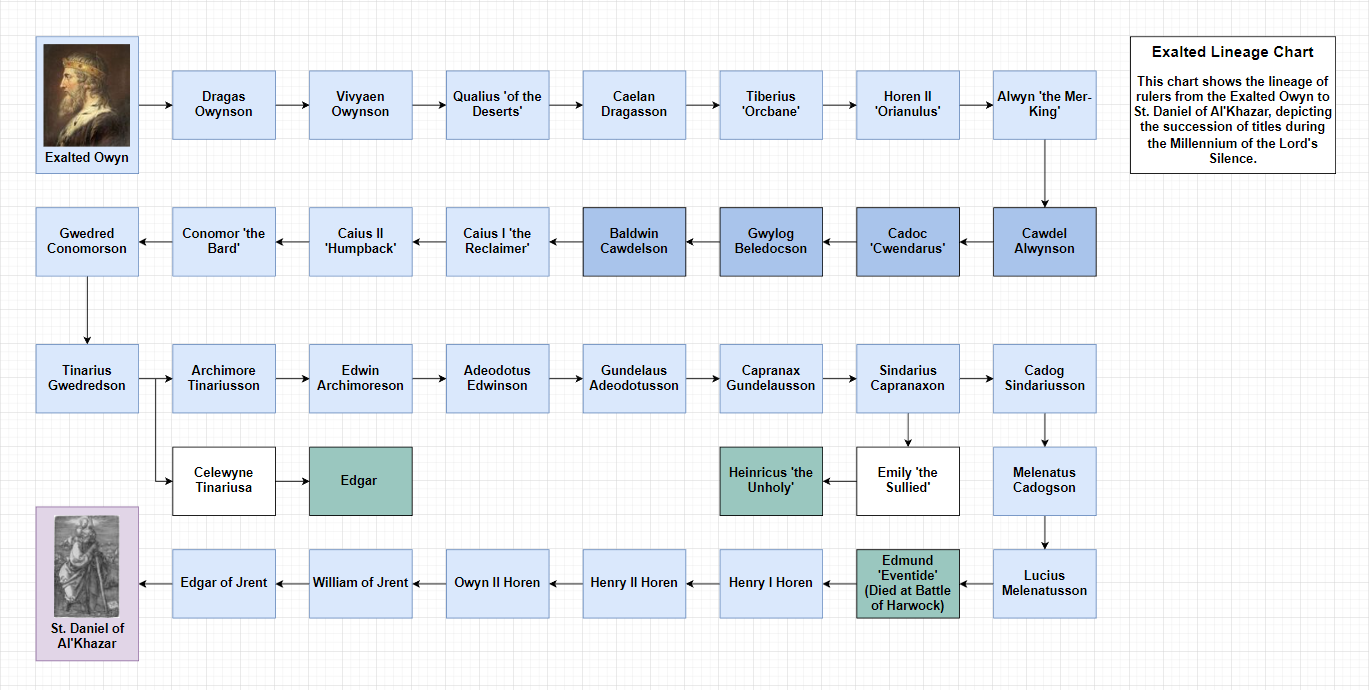 30
30 -
Father Arnaud was ecstatic to both see that the Duke had applied to become a deacon as well as to read such a splendid thesis!
5 -
- Popular Post
- Popular Post
[!] The following hastily written letter would be copied and sent out across Almaris to be spread to all Canonist settlements
Adrian Soldiers Attack Clergy Once Again
A Demand For Justice
To my friend Duke Johanes of Adria,
After the recent instance of a mercenary working in your employ killing a priest of my parish in Minitz and him getting crucified for doing so, I had hoped the troubles between the Church and Adria would be over. Sadly, I have found firsthand today that this is not the case. I was sitting on top of my horse outside Minitz today, together with an altar boy I'm educating to become a priest, Matthias Barclay, as we were preparing to go on a trip. While there, two men dressed in the uniforms of the Free Duchy of Adria showed up and went to stand on either side of us, quick to draw their weapons. I tried to explain to them that we were clergy, that you had given orders not to harass the clergy, that Matthias was just eight years old and I was just a priest. Even telling them the story of what had happened to the mercenary who attacked the priest recently did not change their minds.
I did not resist for I am of the mind we should not raise weapons against our fellow Canonists, that violence is not the answer. Matthias did not resist for he's a young boy. They wanted my horse, our money and our belongings. I tried to talk, but when one of them yanked the young Matthias off of my horse and put the altar boy in a chokehold, I was left no choice but to surrender my horse and all I had on me. Once I was out of the saddle, Matthias was pushed into the dust of the ground, my belongings were taken and they rode off back to Adria on my steed.
Duke Johanes, we have spoken so many times. I've come to view you as a friend in my efforts to mend the divide between the Church and Adria. You did not let me down when that mercenary, who went behind your back by killing a priest, was crucified by my friend Markus and many other Adrians. I ask you now, in my desperation, that you continue to do what is right and take action against the two men who robbed and hurt me and poor Matthias. I demand justice from you, for as I am sure all the rest of Canondom will agree, me and my disciple were wronged by your men. I pray to GOD that this matter be resolved swiftly and justly.
By the Grace of GOD,
Yours truly,
Father Arnaud de Novellen45 -
Full Name of Man - Nikolai Colborn
Date of Birth of Man - 102 SAName of Woman - Katja Amador
Date of Birth of Woman - 104 SALocation of Ceremony - Abbey of St. Robert, Haense
Date of Ceremony (Year) - 126 SA
Name of Clergyman who performed ceremony - Father Arnaud1 -
31 minutes ago, Fishy said:
Pretty good, but there's some that I feel are poorly represented or not listed.
Notes on the Kingdoms:
Kingdom of Kaedrin (Chivay) should be added as a part of the First Empire, be a contributor to the Third Empire, then be spawned from the Republic of Ves with Helvets as a contributor to the Eighth Empire.
Duchy of Adria (Carrion) should be added as a secession from the Reformed Kingdom of Oren that is reabsorbed into the Fifth Empire, it is later reconstituted with Carrion under the Empire of Man then later transformed into the Republic of Ves.
The "Great Orenian Exodus to Aeldin" should be replaced with the Aeldinic Empire (Horenic), as it is where the dynasts emerged for the Third Empire, Fifth Empire, Kingdom of Renatus after the Sixth, and the Seventh Empire respectively.The Empire of Man to Eighth Empire is rather inaccurate, there should be no Empire of Renatus succeeding the Empire of Man, at least none that succeeded the polities that seceded from the Empire of Man. I'm not really sure what the "Empire of Renatus" is besides some forum fiction blogged about at the end of the War of Two Emperor's.
The full political history of the Republic of Ves would be Duchy of Adria (Carrion) > Republic of Ves > Duchy of Cathalon (Helvets) > Kingdom of Kaedrin (Helvets).
The County of Leuven should be Ashford (de Falstaff) and later succeeded by Rubern a mercenary occupation state, later reincorporated into the Eighth Empire.
Kingdom of Norland should be incorporated into one of the Pertinaxi states somewhere, I forget exactly when they took the title but they were within the Empire of Man until the War of the Two Emperor's.Notes on the Dynasties:
It would be better to split Horen and Carrion branches up earlier in the tree.
The Horens of the Fifth Empire were Johannians which would later diverge into Marna, Alstion, and de Joannes respectively.
The Horens of the Kingdom of Renatus after the Sixth Empire, Renatus Marna, and the Empire of Man were the Pertinaxi.
The first Duchy of Adria and the Adria proceeding the Republic of Ves should be noted as Sarkozic, a Carrion branch.Novellen is a Sarkozic branch with Pertinaxi admixture.
Barbanov should similarly be branched from Carrion for the Kingdom of Hanseti-Ruska.
Here's a mockup of some of the changes. Black for Adria, red for Kaedrin, orange for Norland, green for Rubern. There's more I likely missed, but this is off the top of my head.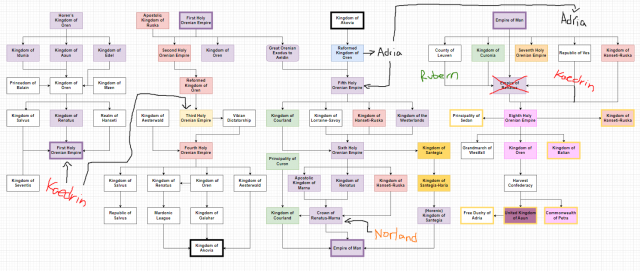
Right some of this is very good feedback, so thank you for that! As for various vassals of the Empire though such as the Duchy of Adria; if they were not independent, I did not add them, at least that's what I'm aiming for. Like every time you see Haense for instance, it was independent either because the Empire had fallen apart, they were fighting against the Emperor or they'd been granted independence from the Empire. I also tried to limit the colours to dynasties, not houses. The only reason Novellen and Alstion were added (and I should have added de Joannes, Alexa is right on that) is because the 'House of Horen' dynasty had been dissolved at that point.4 -
4 minutes ago, Ibn Khaldun said:
Incredibly neat to see and good representation of the Hansetian/Teutonic Order elements as far as I can see! You've got the Aegis timeline correct as far as I remember.
I do want to ask, what are some lore concerning Kingdom of Balain and Mzen? Those names I do not recognize from Aegis-era lore unless it was created post-Aegis map which is fine, just want to learn more.
Not sure if those actually existed or only in lore, but if I recall the source correctly they’re described in the Scroll of Gospel. The Prince of Balain and one King Edmund of Mzen who was of the line of Horen were candidates for the throne of Oren, but the Prince was killed before he could take the throne and the King fell in battle en route to Jrent. Something like that. Then furtherdown it described Oren as having united mankind, so I incorporated these titles into that.
I think for next week I will make a chart depicting the early rulers from Horen to Sigismund. If I do, expect to see more about those figures in that. I would’ve liked to include more detail here but that would’ve made things overcomplicated.
6 -
- Popular Post
- Popular Post
Hello everyone! Another week, another chart: this time I've made for you all a chart that details the lineage of nations ruled by the Horen dynasty* and with it several attached nations. This will hopefully shed some light on the long and - as I very much realized while making this - very complicated history of the human nations of LOTC. How were there Eight Orenian Empires? Which dynasties ruled the Empires? How does it all relate back to Horen? Hopefully those questions will get answered by this chart! But first, some caveats;
1: As with the languages chart; this one might have some issues, I'm not an expert on this topic, I was only around for about half the nations covered in this chart. If you think there's a mistake, feel free to point it out in the comments and I might explain the choices that were made or correct it for a potential future version.
2: This chart does not seek to outline all the different people descended from Horen that ruled at different times - that's what a family tree is for, which already exists - but instead shows the succession of nations. Also, the nations with a golden outline are nations that survive to this day.
3: Dynasties. They exist. This chart leaves out a lot of them and perhaps doesn't do proper justice to some of the ones it depicts, but here's how it works roughly;- Each box represents a nation; if that nation had a dominant dynasty (at least half of the rulers of that nation were of the same dynasty) then the box is coloured for that dynasty. To give an example, the second Reformed Kingdom of Horen had 3 Kings, 2 of which were of the Ashford dynasty, so it gets coloured. The Free Duchy of Adria had a Carrion Duke and a Horen Duke, so there's no dominant dynasty thus no colour.
- With the founding of the Eighth Holy Orenian Empire, the House of Horen was dissolved, thus from that point I won't show it as the same dynasty anymore. Instead from there I've used Novellen and Alstion as seperate dynasties.
-
Purple: Horen
Red: Carrion
Yellow: Chivay
Blue: Ashford
Green: Courland
Gold: Savin
Orange: Marna
Pink: Novellen
Burgundy: Alstion
4. There's 2 kinds of arrows connecting the various nations. A vertical arrow means the relation is one of succession, with one state succeeding the other. A horizontal arrow depicts a relation of annexation or secession, depending on which way the arrow points.
5. The tree has been cut up in 4 parts which were placed next to eachother, because it was incredibly long. This way you can actually see it compactly.
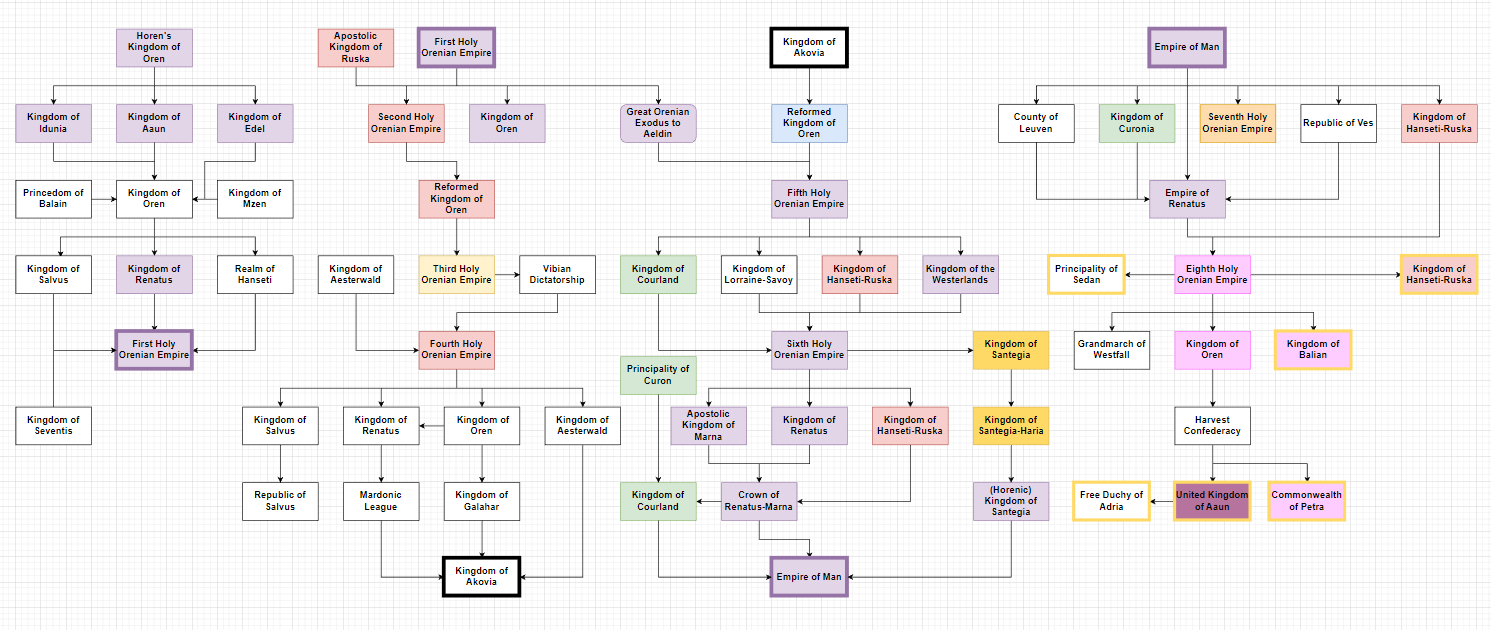
I hope this is useful to the lot of you! These are pretty fun to make, so with the previous chart getting received so well, I figured I'd make you another. Make sure to let me know what you think! (And +1, I feed on the forum reputation!)
54 -
In regards to all the errors and suggested alterations; there were a lot of languages with a lot of lore - my research into how exactly these are all connected wasn't that deep, hence all your suggestions of course!
I do not intend to alter the tree any time soon, because figuring everything out would be a hassle, but I might do a revised and improved version in the future. So if you have suggestions for what should be changed and such, keep them coming and I might incorporate them into a future revised version!
(Also, good disclaimer that some people made here; careful about using this as irp knowledge considering that some of these languages aren't known by outsiders at all. You don't wanna get tripped up in metagaming accusations, so just use this to further your ooc understanding of things!)3 -
27 minutes ago, Arafel said:
Where's Adunian?
The people who gave me feedback didn’t think Adunians had their own language, nor did I find such.4 hours ago, TaytoTot said:I didn't know Reinmaren was it's own language? I simply believe that's just the word for people who live there not a language. Though, I totally could be wrong
I thought it was the same as Waldenian, but I read it being described as its own thing in a few places so I put it in for good measure.5 hours ago, Samler said:Beyond the dark elven amelgamation of Ancient Elven and Blah- What changes has there been to the elven language and which group uses this 'elvish'?
So ‘Elvish’ would just be the standard Elven that is spoken today, while ‘Ancient Elven’ would be the same language 10 years ago or whatever. I know Ancient Elven has had various additions to the vocabulary as well as maybe some grammatical changes though of that I’m not so sure. So yeah, not wholly separate languages, moreso change over time and a change in how people name it (I’ve heard Elvish being used the past year or two, I think Ancient Elven has kinda fallen out of use.)Again though, not a perfect chart, feel free to disagree.
1 -
4 minutes ago, _pr0fit said:
I'm not sure if you want this to be an irp or ooc guide, if its irp then ignore me, however if you would like a more correct guide, Jalfmarr'tal and Old Norlandic are inspired by the same culture and language ooc, but irp they are not at all related and neither one is a descendant or progenitor of the other, and the cultures for those two languages have nothing to do with each other, but, Lakian and Old Norlandic are related and Lakian is not related to Raev, despite their cultures being similar.
I think this is really cool, and it would be neat if the staff could find somewhere for this information to be more easily accessible for future projects.
Edit: Additionally, Old Norlandic would be a descendant language of Narvaukian.
While making this I received some feedback on how the “norlandic languages” relate to one another, and apparently its a bit controversial as to whats what. Part of the problem is indeed the matter of do you link them based on backstory or similarity? I don’t think I am well-versed enough in Norland’s lore to properly sort it out, but if you think you can, I welcome you to make your own visualization of how all those languages are related.3 -
52 minutes ago, Samler said:
What is the difference of 'Ancient Elven' and 'Elvish'? I think I would also had noted Blah and Ancient Elven closer due to at least one shared word, but that might be nit-picking.
Afaik there have been a lot of small changes to the Elven language over the years, so the Elvish thats in use by some now is a bit different from the original. As for the connection with Blah, I was not aware of that, but if its not derived from it or decently influenced, then yeah its probably nit-picking.3 -
26 minutes ago, Lirinya said:
so this is what you do in your spare time, sander
Shhhhh5 -
Full Name of Man - Skaul Skaul
Date of Birth of Man - 98 SAName of Woman - Khovago Chommi
Date of Birth of Woman - 99 SALocation of Ceremony - Valwyck, Haense
Date of Ceremony (Year) - 125 SA
Name of Clergyman who performed ceremony - Father Arnaud1 -
- Popular Post
- Popular Post
Hello everyone!
Very simple 'guide' here; LOTC has a lot of roleplay languages - be they custom languages or roleplay-friendly equivalents of real life languages. With all these languages though, it can be hard to get a sense of what's what and how they're all related. For that reason I've made a 'language tree' that shows how various languages are related or derived from one another. While making this I've had countless people giving feedback about languages that were still missing or that should be moved to different spots, so by no means is this a definitive or perfect representation. Still, I think it can be helpful for a lot of people and it visualizes the rich variety of languages we have on LOTC!
A few general points of elaboration about the tree:- The colours generally represent language families like how you would have 'Slavic' and 'Germanic' language families in real life. These can sometimes come together as joint influences on a language, creating a mixed color.
- The tree is made from a Canonist point of view because it offers the most complete and coherent tree, that's the reason most languages trace back to Flexio. Depending on your character's interpretation of religion, the creation of the world etc. this might alter, but this is probably the most widely accepted view of things, even if it means Elven and Dwed stem from what's essentially Latin.
- There's a lot of languages on this tree, many of which are small or have fallen out of use. To list what each of them are would be a bit cumbersome, but I do believe all of these can either be found on the forum or wiki, so you can look up any you do not know!
- The 'languages' Harrenic, Jorenic, Ancient Southeron, Ancient Farfolk and Ancient Easterling are not literal languages, but moreso represent a step in the language evolution process that's muddled, consists of a plethora of minor theoretical languages, or represent a missing link. Ghanya doesn't look like Flexio, but to my knowledge there's no information on what languages link them. We know they must be linked though because the Southeron descend from Harren, hence the labels to represent these missing links

If you have any questions, feel free to ask; I might answer them!
(Also u better gimme +1, this was a hassle, I swear there's way too many unused languages that were made up at some point as part of lore that barely got used.....)96 -
Saulite Infiltration
A letter by a worried Clergyman

To the Church of the Canon in general and her Inquisition specifically,
It has come to my attention that for years now, decades, perhaps nigh on a century, there has been a vile heresy subtly infiltrating the mainstream of the Canonist church. Hidden in plain sight, this festering must have survived generations of clergymen who perhaps never noticed, didn’t know any better or, God forbid, didn’t care. I am talking about works by the Saulites.For those who are unaware or perhaps reading this as laymen, let me outline in a few brief sentences who the Saulites are. The Saulites are a heretical sect, a cult if you will, of Canonism. Their namesake is a man called Saul, described in the Scroll of Gospel to be of Horen’s tribe. In the gospel, Saul ignores the warnings of Julia and Horen about Iblees, going to speak with the latter. He gets tempted by Iblees and makes a deal, being given the appearance of Horen after which he sets about spreading sin among mankind, corrupting many. The Saulites are an evil sect, known for preaching false teachings, a lack of morality and a twisted sense of worshiping Evil.
With that out of the way, how have these Saulites been infiltrating Canonism? Books. While spending time in several libraries, a particular title caught my eye; “Saulite Hymn”. When I first read that, I didn’t know who the Saulites were yet, but I recognized the name Saul from the Gospel and started my research. This hymn preaches a twisted mockery of the good Faith and I do not recommend anyone read its perversions. How these books came to be part of any canonist library’s collection is beyond me, but I assume there must have been a Saulite in the past who donated these books to a variety of libraries. The librarians didn’t know who the Saulites were but saw that this was a religious book, and thus put it among the other Canonist literature.
Now the real question here is; how widespread is this infiltration? Sadly, I can only give a partial answer to this. The aforementioned book, Saulite Hymn, is worryingly found in various libraries across Almaris. This, shockingly, includes the Library of the Holy See itself of all places. Thus, this specific book is quite widespread but if it is the only book, it is not a major issue one might say; simply get rid of this title. The issue is however: I fear we cannot be sure this is the only heretical book that sits in Canonist libraries. I traced the Saulite Hymn back to library records from at least 80 years ago, they might have been there sooner, and all this time they went unnoticed so who is to say that there aren’t more heretical books like this one: hiding in plain sight?
This brings us to the purpose of my letter. I wish to ask the Church and the Inquisition to take action on this matter. Of the Church I ask that this book, the Saulite Hymn, be removed from all Canonist libraries across the continent on the sinful charges of Peccat contra Fidem: Blasphemy, Heresy, Sacrilege, Incredulity and Peccat contra Mores: Saulicy. Of the Inquisition I would like to ask that they start an investigation into the literature that makes up the Religion sections of said libraries in an attempt to root out any other books that are based on Saulite or other heresies. These books have been read by laymen and clergymen alike, possibly even Acolytes studying to become Priests. They shape Canonists’ views of the Faith.
We cannot have heretical books infiltrate Canonist libraries, for such means they infiltrate the Canonist minds and ultimately the Canonist Faith itself.Signed,
Arnaud de Novellen
19 -
Arnaud de Novellen slept peacefully, knowing the best possible candidate had been elected to be the next High Pontiff.
8 -
MC Name: Sanders_Name
Discord: Sander#0004
Image:

Description of Image: A fresco to be used as decoration in a church.
Dimensions: 3 wide, 2 high
1 -
MC Name: Sanders_Name
Discord: Sander#0004
Image:

Description of Image: A fresco to be used as decoration in a church.
Dimensions: 3 wide, 2 high
2 -
MC Name: Sanders_Name
Discord: Sander#0004
Image:

Description of Image: A fresco to be used as decoration in a church.
Dimensions: 3 wide, 2 high
1 -
Acolyte Arnaud sighed deeply as he came up to the second floor of the clinic again the day after the incident. He’d eye the unconscious Ludrik with a mix of emotions; the man had attacked him, but he’d heard some stories about what had happened to the Katzak and he’d met him in church as a decent man. In the end, the acolyte did what he came in to do before leaving; he’d light some incense beside the bed and say a few prayers for the injured Ludrik.
3 -
Arnaud de Novellen's jaw dropped as he read the news, dumbfounded at the High Pontiff's passing "He.. He seemed alright last Saint's day... How..." He sighed "There goes a good man and a good servant of the Lord... May he find rest in the Seven Skies."
6





VICESIMA PRIMA AUREA BULLA JORENUS
in Ecclesiastical Decrees
Posted
Father Arnaud, now Cardinal Arnaud spreads the Golden Bull around, happy to finally see it declared.